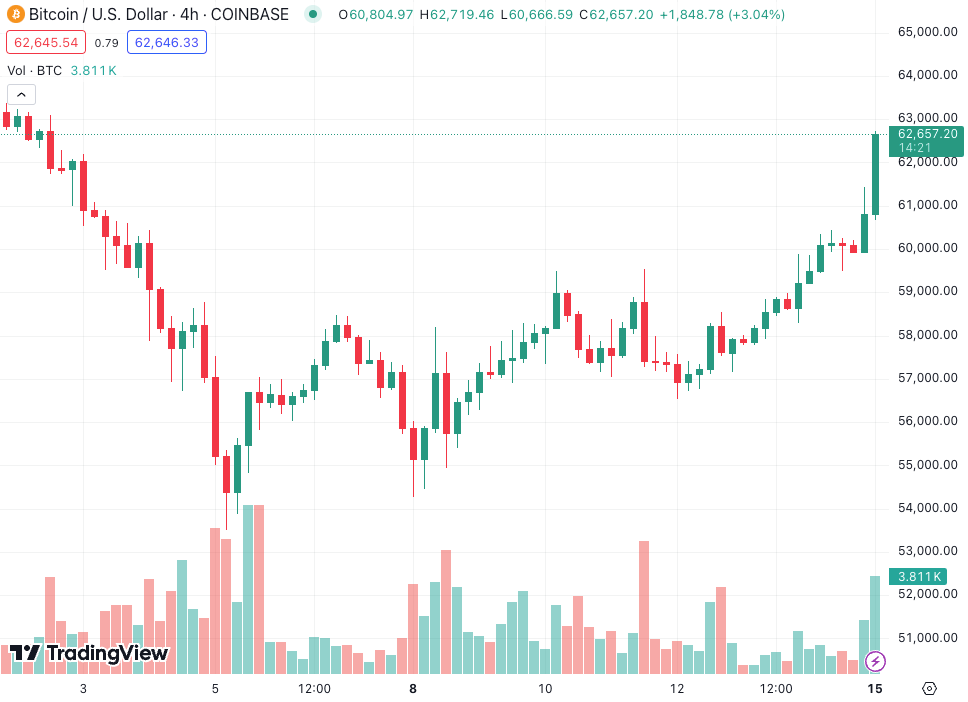The Bitcoin price has bounced back above $62,000, with analysts optimistic that the worst might be over. Germany has finished its forced sales, and Mt. Gox repayments are mostly accounted for.
The price of Bitcoin has rallied 5.2% in the last 24 hours, recovering from a two-month low of $53,500 on July 4th, and is now trading at around $62,800, according to TradingView data.

Ben Simpson, the founder of the crypto education platform Collective Shift, told Cointelegraph that he believes Bitcoin has hit its “local bottom” and is now on an uptrend.
According to Simpson, Bitcoin price had been heavily impacted by around $3 billion in forced sales by the German government and concerns over $8.5 billion in Mt. Gox creditor repayments.
On July 12, when Bitcoin hovered around $59,000, the Crypto Fear & Greed Index dropped to its lowest point in 18 months. Simpson noted that this fear was inconsistent with the broader market’s fundamentals.
“Generally, I just felt there was a very big mismatch between sentiment and fundamentals,” he said.
Looking ahead, Simpson sees several important factors that could boost Bitcoin’s price in the coming weeks and months.
“Jerome Powell is hinting towards potentially lowering rates at some point soon. We’ve also got the S&P 500 ripping to new highs amongst all of this as well as strong Bitcoin ETF inflows flowing back in.”
According to Coinglass data shared by Apollo Sats founder Thomas Fahrer on July 15, over $360 million in leveraged short positions on Bitcoin were liquidated when Bitcoin passed the $62,000 mark.
eToro market analyst Josh Gilbert told Cointelegraph that the worst of Bitcoin’s price drop might be over. He believes that one key factor for Bitcoin’s positive price movement in the coming months could be Trump’s improved chances in the upcoming election.
“We’ve seen weakness in the last few months, but I think the worst is likely behind us. Any short-term weakness is likely to be bought with this in mind, alongside the tailwind of an ETH ETF and, of course, a more pro-crypto US party potentially being elected.”
“The attack on former President Trump this week has positively impacted his reelection odds, with the former President’s pro-crypto stance lifting Bitcoin and crypto assets in the process,” Gilbert said.
Gilbert also mentioned that Trump and the Republicans are more supportive of crypto compared to the Democrats.
“The closer we move to Trump potentially gaining his spot back in the White House, the higher we’re likely to see Bitcoin move,” he added.
A Bitcoin Surge Won’t Happen Overnight
Gustavo Schwenkler, director of the Australian crypto exchange Cointree, explained to Cointelegraph that the impact of Mt. Gox creditors selling their Bitcoin has already been accounted for in the market since last week.
Schwenkler believes that lower-than-expected inflation in the US and hints of reduced interest rates are significant factors that could drive the crypto markets forward.
“Inflation came out lower than expected and expectations that the Fed will start cutting rates got a boost. The market is now expecting first-rate cuts as soon as September,” he said.
Still, Schwenkler cautioned that any possible rise in Bitcoin’s price is unlikely to happen quickly.
“I also don’t think there’s going to be a lot of push for the price to go much higher in the short run. I think we will see BTC move around $55-65k at least until the Fed actually cuts rates.”
Mark Hiriart, head of sales at crypto asset manager Zerocap, suggests that even though Bitcoin surpassed $62,000, it must stabilize above the $60,000 level to solidify this as a support level.
He also highlighted that Bitcoin needs to regain its crucial 50-day and 100-day moving averages before it can move towards $65,000 and beyond.
However, Hiriart cautioned that there might still be challenges ahead, especially concerning the potential impacts of Mt. Gox Bitcoin repayments.
“With Mt. Gox’s creditors sitting on a ten-year profit, it would be naive to think there won’t be any profit taking,” he said.
“The question is how staggered are the distributions and what percentage of recipients want to cash in. I would suspect short-term pressure on the market to continue over the Summer months,” Hirairt added.

